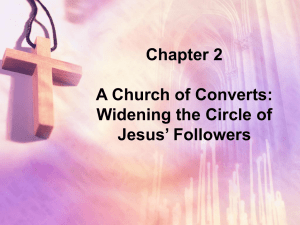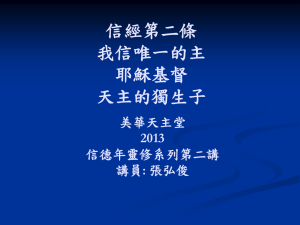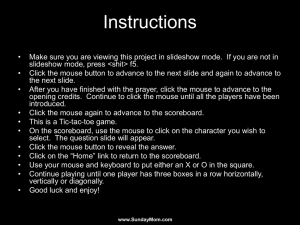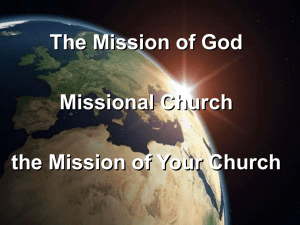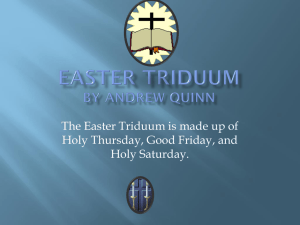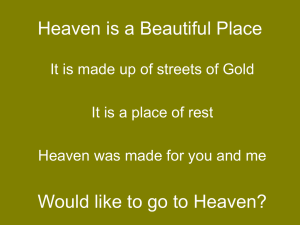Sacred Scripture – New Testament: Gospel
advertisement
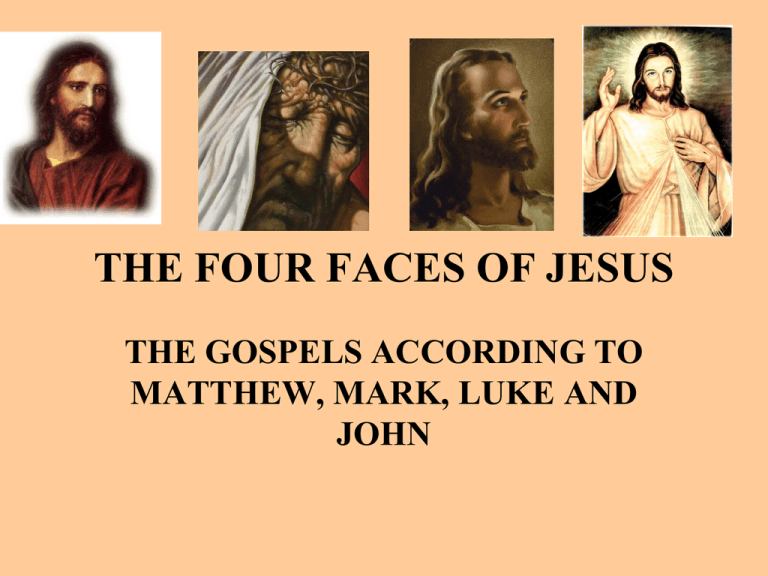
THE FOUR FACES OF JESUS THE GOSPELS ACCORDING TO MATTHEW, MARK, LUKE AND JOHN OVERVIEW • AUTHORS – WHO – WHEN • SUMMARY – ORGANIZATION – STYLE – AUDIENCE • MESSAGE THE ANOINTED,THE CHRIST, THE MESSIAH • MESSIAH (English Trans.) – A Hebrew word meaning "the anointed one." – In the Old Testament the high priests and the kings were anointed. – But the name Messiah was used among the Israelites for Him alone who was foretold to Adam and Abraham as the “Savior from sin and the blessing of all nations” • (Gen. 3:15; 12:3; 22:18). • Old Testament, prophecies about Him constantly sustain hope in and desire for His coming. – He would have a precursor • (Mal. 3:1); – His birth of a virgin was foretold • (Is. 7:14; Jer. 31:22); – the time of His coming was revealed to Daniel • (Dan. 9:24); – even the place of His birth was designated • (Mic. 5:2); – His reign was described • (Jer. 23:5); – He would enter the rebuilt Temple • (Hag. 2:8; Mal. 3:1); – He was to abide among men and would suffer a cruel passion and death at their hands to redeem mankind • (Is. 42:1-4; 53:1-12); – and was to rise from the dead as a proof of His divinity • (Hosea 6:2, Ps 16:10). CHRIST FORETOLD THE FOUR FACES OF JESUS • Same general purpose • Own style and flavor • Four different authors • Four different traditions THE FOUR FACES OF JESUS Jesus’ words and actions received a new light, a new depth and fuller interpretation than was possible before the resurrection and the coming of the Spirit. They were passed on in new situations, and according to the mentality, culture and need of new hearers. The Gospel of Matthew JESUS THE KING MATTHEW • Matthew (Levi) the disciple and tax collector wrote 40-90 AD – Original Aramaic and “sayings” versus later Greek text still debated • Longest Gospel at 28 chapters • Known as a book of “teaching” – Law, mission, mystery, greatness, and future • Infancy Narrative – (1:1 – 2:23) • Proclamation of the Kingdom – (3:1 – 7:29) • Ministry and Mission in Galilee – (8:1 – 11:1) • Opposition from Israel – (11:2 – 13:53) • Jesus, Kingdom and Church – (13:54 – 18:35) • Ministry Judea, Jerusalem – (19:1 – 25:46) • Passion and Resurrection – ( 26:1 – 28:20) Matthew’s Organization Matthew’s Style • Jesus the King, descendent of David – Genealogy traced to David – Son of David mentioned 10 times – Visited by Kings at birth • The fulfillment of prophecy – Virgin birth (brief), Bethlehem, innocents – Quotes the prophets • The Teacher – Calls his own gospel a “book” – Beatitudes, law, anger, adultery, divorce, oaths, retaliation, almsgiving, prayer Matthew’s Style cont. • Teaches us to pray. – (6:10) • Establishes the Church and authority to Apostles – (16:18, 18:18 twice) • Gives Peter the Keys to the Kingdom • Peter 195, others 130, John 29 Matthew’s Audience • Primarily Jewish/Jewish Christians – “Kingdom of Heaven” vs “Kingdom of God” • 32 times in 31 verses • Exclusive to Matthew – “King of the Jews” – Magi, Crucifixion – OT similarities: 40 years/40 days, Moses mount/sermon on mount, 12 tribes/12 apostles, – Matthew focuses on “tradition” (not gentile trait) Matthew’s Message • Jesus is Messiah prophesized in OT of the lineage of David • Jesus was Son of God and sinless • Jesus performed miracles beyond nature – Calm storm, healing, raising dead • Jesus gives examples of how to live – Parables: faith, salvation, sacrifice, love, legal issues, forgiveness, temptation, hypocrisy, giving to others, Heaven and Hell The Gospel of Mark JESUS THE SUFFERING SERVANT The Gospel of Mark • John Mark a follower of Peter – Mentioned in: Acts 12/13, Col 4:10, 2 Tim 4:11 (obscure) • Written 50 - 60 AD – Before Jewish War 66-70 • Calls his account a “gospel” • Shortest gospel with 16 chapters – Last five deal with entry into Jerusalem, passion, death, and resurrection – Omits genealogy and birth • – • – • • – – Preparation of public ministry (1-1:13) • John the Baptist, Jesus’ baptism, Jesus' temptation The Mystery and Ministry of Jesus (1:14-8:26) • Calling Peter/Andrew, Beginning miracles, parables Beginning of the Revelation (8:27-9:32) • Peters confession (not the keys to kingdom), Prediction of passion, Transfiguration The Full Revelation (9:33-16:20) • • Greatest in the kingdom, Marriage and divorce, Jerusalem, Last Supper, Crucifixion Two endings (long ending, short ending) Mark Organization • Presents Jesus as a servant obedient to the Father and way of the cross – “For the Son of Man came not to be served but to serve” (10:45) – No information about Jesus before baptism • Jesus has authority – “…he speaks with authority, power” (1:27) – Repeated controls the forces of evil, darkness, disease, nature • Jesus speaks of fulfillment, nearness of kingdom, and need for repentance and faith – (1:14-15) Mark’s Style • “Son of Mary” “a carpenter” (not son) • No conversation w/ Satan in wilderness, very brief description • “Sabbath made for man” unique (2:27) • “brothers” and “sisters” named (6:3) • Only Gospel that Jesus admits he doesn’t know when the end of the world will come (13:32) Mark’s style • Messianic “secret” stronger in Mark – (1:34 vs Matt 8:16, 5:43,7:36,8:23) • Only direct answer to Sanhedrin : – “Are you the Christ?” “I am” • (14:62) • “visual gospel” – (6:39) • Jesus’ death predicted 3 times and apostles misunderstand each time – (8:31,931:10:33) Mark’s Style cont. Mark’s Audience • Greek speaking residents of Rome – Jewish traditions are explained • (7:1-4) – Aramaic words are expanded • (5:41) Mark’s Message • Jesus is Son of God (1:1, 15:39) • Jesus died for many that sins might be forgiven. (10:45) – Emphasis on the passion, death and resurrection – Last five chapters of 16 deal with this • Eternal salvation is real and through Jesus The Gospel of Luke JESUS THE HUMANITARIAN Gospel of Luke • Author a doctor and companion of Paul (obscure) – Also wrote Acts of Apostles – Well educated – Works comprise 28% of NT • Gives complete history of Jesus from birth to resurrection. – Uses names to place dates of event • Calls his gospel a “narrative” • Probably written between 5860 AD • Author ref. in Col 4:14 St. Luke by El Greco Luke’s Organization • Prologue (1:1-4) • Infancy Narrative (1:5- 2:52) – Genealogy goes back to God • Preparation for Ministry (3:14:13) • Ministry in Galilee (4:14 – 9:50) • Journey to Jerusalem (9:51 – 19:27) • Teaching in Jerusalem (19:28 – 21:38) • The Passion Narrative (22:1 – 23:56) • The Resurrection Narrative (24:1-53) Luke’s Style • Jesus the “social worker” • Very descriptive covering large time frame – Much scrutiny based on historical comparisons available – Very accurate in descriptions geographically, politically, and nautically. • Paints Jesus as a teacher, ethically wise, serene, interested in teaching virtues among people • Jesus is powerful and knowledgeable (4:16 - 22) • Appears more socially and politically conscious Luke’s Style cont. • Jesus more of a teacher, critical yet still concerned about society. • Jesus’ death calmer w/ different words than Matt/Mk • Pilate’s responsibility mitigated – Political/social consideration • Jewish responsibility more significant – Gentile perspective Luke’s Audience • Gentiles and well educated based on his language • Highlights more political and social concerns • Possible concern for the way Christians will be perceived Luke’s Message • For Theophilus and others to “…realize the certainty of the teachings (Christian truths)…” • Jesus is the Son of Man who “…came to seek and save what was lost” (19:10) – Humanity – Genealogy goes back to Adam “son of God” – “…all who heard were astounded…” • Christ shows us our humanity with his love • Christ is God The Gospel of John JESUS THE DIVINE Gospel of John • The Lord’s closest friend “the beloved” – Part of the inner circle of Peter and James – “Behold your Mother, behold your son” • Written after 90 AD • Covers last 3 years of Jesus John’s Organization • Prologue (1:1-18) – The Incarnate Word of God – No baptism, only John the Baptist • Book of Signs (1:19 – 12:50) – Wondrous deeds of Jesus • Book of Glory (13:1 – 20:31) – Meaning of the passion, death, and resurrection • Epilogue: Resurrection Appearance in Galilee ( 21:125) John’s Style • Jesus is God, John explains the “signs” – Cana (2:11), Cleansing of Temple (2:18 – 22) • Full explanation of the Real Presence – The “heart” of the Eucharist (6:48 - 69) – The “Light of the World” (9:1 -5) – The “Glory of God” (11:4) • The Glory – “You do not always have me” (12:8) – “While you have the light, believe in the light (12:36) John’s Style cont. – “what I am doing you do not understand but will understand later” (13:7) – “Now is the Son of Man glorified”(13:3) • Introduces the “Advocate” the spirit (14:16) – The spirit that will teach (14:26) • No “Last Supper” narrative – Extensive “discourses” • Passion, crucifixion and death – “his Mother” at crucifixion and given to John – Thomas doubts and is shown John’s Style cont. • Epilogue unique – Third time Jesus revealed after resurrection – No ascension described – Two “conclusions” (20:30) (21:24) – Although possibly written after manuscript complete, epilogue is in earliest available manuscripts. John’s Audience • Gentile Christians – Explains Jewish customs – Describes places in Palestine John’s Message • “…these are written that you may believe that Jesus is the Christ, the Son of God, and that believing you may have life in His name.” (20:31) • “It is this disciple who testifies to these things and has written them…There are many other thing Jesus did…I do not think … world would contain the books (21:24) THE FOUR FACES OF JESUS • Matthew – The Christian Rabbi and King intent on catechesis concentrates on fulfillment of scripture. • Mark – Focuses on what Jesus did rather than what he said, on his suffering humanness rather than his divinity. • Luke – Concentrates on on Jesus’ mercy, Christian prayer and the poor . • John – Presents a majestic, divine Jesus, and a Kingdom of salvation already in force. THE GOSPEL MESSAGE “…Christ died for our sins in accordance with the scriptures…he was buried…he was raised on the third day in accordance with the scriptures…” 1 Cor 15:3-5)

